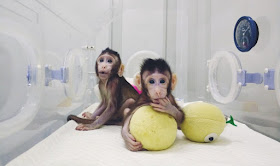Saturday, February 3, 2018
Chinese Scientists Successfully Clone Monkeys
The twin macaques, named Zhong Zhong and Hua Hua, are the first primates to be cloned using somatic cell nuclear transfer.
AsianScientist (Feb. 1, 2018) – Scientists in China have cloned monkeys by refining the technique used in the cloning of Dolly the sheep. Their findings are published in the journal Cell.
Over 20 years ago, a technique known as somatic cell nuclear transfer (SCNT) was used to create Dolly the sheep. This method involves the removal of the nucleus from an egg cell and replacing it with another nucleus from differentiated body cells. This reconstructed egg then develops into a clone of whatever donated the replacement nucleus.
n this study, scientists led by Professor Sun Qiang, director of the Nonhuman Primate Research Facility at the Chinese Academy of Sciences (CAS) Institute of Neuroscience, created the first primate clones using SCNT. The researchers named the newborns Zhong Zhong and Hua Hua, after the Chinese adjective zhonghua, which means Chinese nation, or people.
Differentiated monkey cell nuclei, compared to other mammals such as mice or dogs, have proven resistant to SCNT. The first author of the paper, Dr. Liu Zhen of the CAS Institute of Neuroscience, spent three years practicing and optimizing the SCNT procedure. This included the quick and precise removal of the nuclear material from the egg cell, as well as various methods of promoting the fusion of the nucleus-donor cell and enucleated egg. The researchers then introduced epigenetic modulators that helped to re-activate genes that had been suppressed in the differentiated nucleus.
“The SCNT procedure is rather delicate, so the faster you do it, the less damage to the egg occurs. Liu has become proficient at doing this,” said Dr. Poo Muming, a co-author on the study, who directs the Institute of Neuroscience of CAS Center for Excellence in Brain Science and Intelligence Technology.
The researchers noted that nuclei from adult donor cells produced offspring that only lived for a few hours after birth. Their success rate increased when they used nuclei taken from fetal donor cells such as fibroblasts, a cell type in the connective tissue. Zhong Zhong and Hua Hua are clones of the same macaque from which the fetal fibroblasts were obtained.
The researchers plan to continue improving the technique, which will also benefit from future work in other labs. They will also monitor Zhong Zhong and Hua Hua for their physical and intellectual development. The baby macaques are currently bottle-fed and are growing normally compared to monkeys their age. The group is also expecting more macaque clones to be born over the coming months.
The lab is following strict international guidelines for animal research set by the US National Institutes of Health, but the researchers encourage the scientific community to discuss what should or should not be acceptable practices when it comes to the cloning of non-human primates.
“There are a lot of questions about primate biology that can be studied with this animal model. You can produce cloned monkeys with the same genetic background except for the gene you manipulated. This will generate real models, not just for genetic brain diseases, but also cancer, immune or metabolic disorders. We can also test the efficacy of the drugs for these conditions before clinical use,” said Sun.


No comments:
Post a Comment